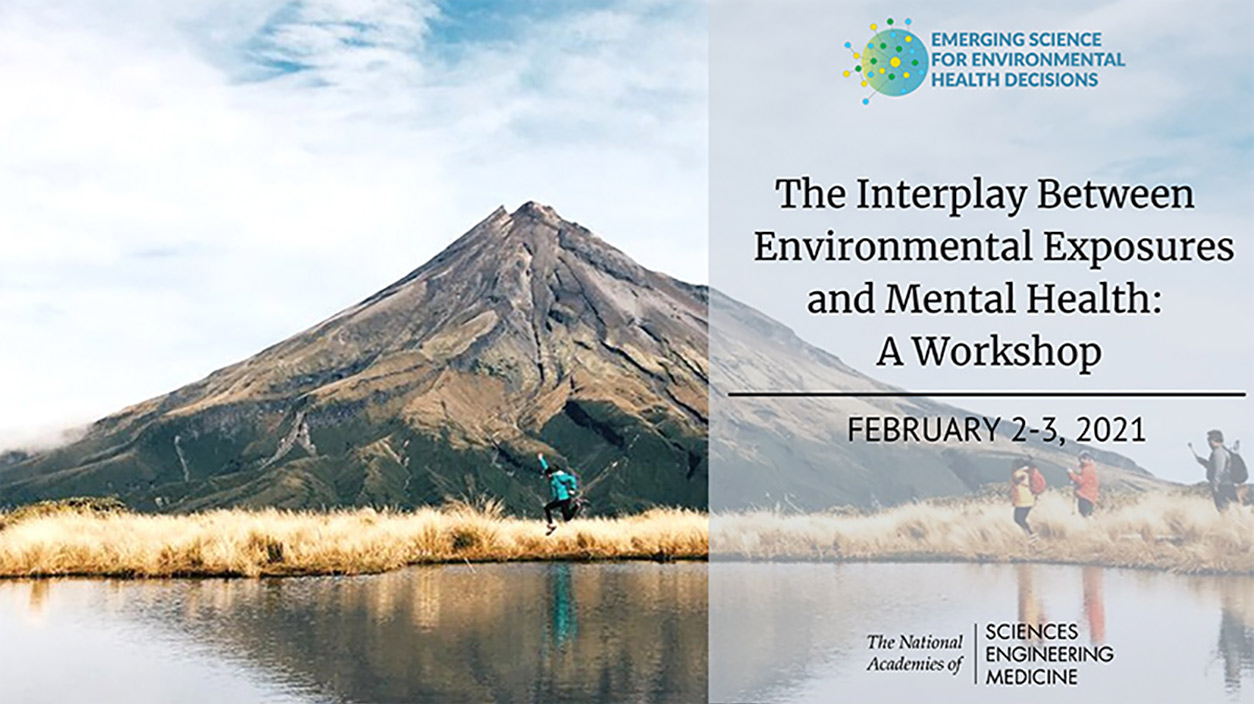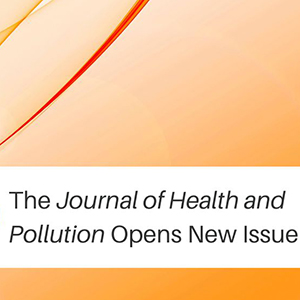There is growing evidence that the environment plays an important role in mental health. Yet, according to the National Academies of Sciences, Engineering, and Medicine (NASEM), research into the effects of environmental stressors rarely focuses on behavioral and mental health outcomes.
On Feb. 2-3, mental and environmental health researchers joined policy experts in a NASEM-sponsored workshop. Participants explored emerging science on relationships — both harmful and beneficial — between environmental exposures and mental health.
 (Image courtesy of NASEM)
(Image courtesy of NASEM)Environment holds risks, offers protection
In his opening presentation (see video, right), Joshua Gordon, M.D., Ph.D., director of the National Institute of Mental Health (NIMH), pointed out that environmental factors present both risk and protective influences on mental health. He grouped such factors into three types.
 Gordon, shown here during his keynote address at an NIEHS workshop, joined NIMH in 2016. (Photo courtesy of Steve McCaw / NIEHS)
Gordon, shown here during his keynote address at an NIEHS workshop, joined NIMH in 2016. (Photo courtesy of Steve McCaw / NIEHS)- Individual factors such as the microbiome.
- Natural and built components include green spaces, housing, and highways, which may play a role in health disparities.
- Social factors like family structure, poverty, and other social determinants of health.
Gordon explained that the NIMH strategic plan calls for exploring mechanisms behind these influences. “We are interested in mechanistic relationships specifically because that allows us to build interventions that reduce risk and increase resilience,” he said.
The workshop planning committee, chaired by Gina Solomon, M.D., from the University of California, San Francisco, organized the event around four topics.
- Mental health and pollutants, especially air pollution, pesticides, and metals.
- Environmental disruptions such as climate change and chemical spills.
- Benefits of a healthy environment, including community action and resilience, and how they may lessen health disparities.
- Opportunities to advance emerging tools and technologies, collaborations, and public health policy.
Calls for collaboration
NIEHS and National Toxicology Program Director Rick Woychik, Ph.D., in his opening remarks, looked to opportunities for more collaborative work between researchers.
Gary Miller, Ph.D., an NIEHS grant recipient from Columbia University (see related article), said the workshop clearly demonstrated that scientists already know a lot about how we can improve mental health across a population by improving the environment. He emphasized the need for collaboration across disciplines — genomics, toxicology, psychology, psychiatry, and economics, to name a few — as well as with communities.
Decisions on local zoning codes, public housing architecture and green space, and infrastructure such as dams and highways can all affect mental health. “Unfortunately, this knowledge is not being transferred to these decisionmakers,” he said.
Environment matters
Evidence that the environment matters falls into three areas, according to keynote speaker Sandro Galea, M.D., Dr.P.H., from the Boston University School of Public Health.
 Galea stressed the need for innovative thinking. “Our methods often fall short,” he said, with respect to environmental pathogens, disruptions, and forms. (Photo courtesy of Sandro Galea)
Galea stressed the need for innovative thinking. “Our methods often fall short,” he said, with respect to environmental pathogens, disruptions, and forms. (Photo courtesy of Sandro Galea)- Among the best known environmental contaminants and pathogens is the connection between childhood blood lead and psychopathology later in life. Other examples include pesticides and fine particulate matter air pollution.
- Environmental disruptions such as earthquakes, hurricanes, and the September 11 attacks usher in post-traumatic stress disorder, depression, and other outcomes, which may linger long after infrastructure and homes are repaired. The COVID-19 pandemic is wreaking effects on income, social relationships, and culture.
- “Environmental form fundamentally influences mental health,” Galea said, referring to green space, tree canopy, and open space. Segregation and the redlining that enforced it are another aspect of this concept. “Form … does not just happen. Form is constructed from policies followed over time.”
Large studies to provide crucial data
According to Nora Volkow, M.D., director of the National Institute on Drug Abuse, striking evidence for the importance of socioeconomic status in brain development underscores the need to study complex systems. She highlighted National Institutes of Health studies large enough to potentially reveal more about these connections.
 Hollander organized an NIEHS workshop on psychiatric disorders and exposures, shown here at that event, and authored a review paper on the subject. (Photo courtesy of Steve McCaw / NIEHS)
Hollander organized an NIEHS workshop on psychiatric disorders and exposures, shown here at that event, and authored a review paper on the subject. (Photo courtesy of Steve McCaw / NIEHS)- Adolescent Brain Cognitive Development (ABCD) offers open access data on exposures in children beginning at 8 to 10 years of age.
- Healthy Brain and Child Development, in partnership with NIMH and NIEHS, complements ABCD by starting at infancy.
- All of Us will follow one million Americans, with extraordinary scientific possibilities.
Jonathan Hollander, Ph.D., from NIEHS, highlighted tools and technologies for assessing exposures that influence mental health. He discussed how exposures might be incorporated into mental health classifications.
Hollander oversees NIEHS grant funding for psychiatric disorders, neurodegenerative diseases, and neurodevelopmental toxicity, among others. See sidebar for his discussion of a current funding opportunity in mental and environmental health.
Citation: Reuben A, Schaefer JD, Moffitt TE, Broadbent J, Harrington H, Houts RM, Ramrakha S, Poulton R, Caspi A. 2019. Association of childhood lead exposure with adult personality traits and lifelong mental health. JAMA Psychiatry 76(4):418–425.










